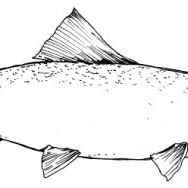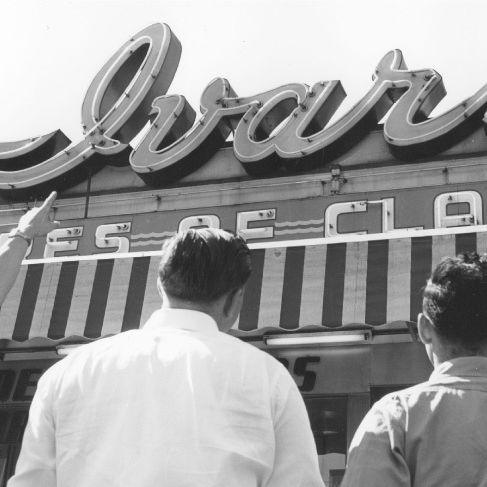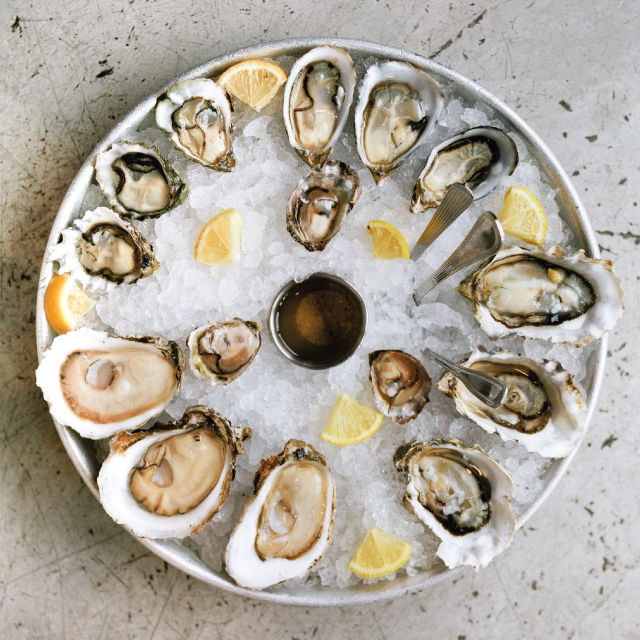Seattle’s Best Seafood
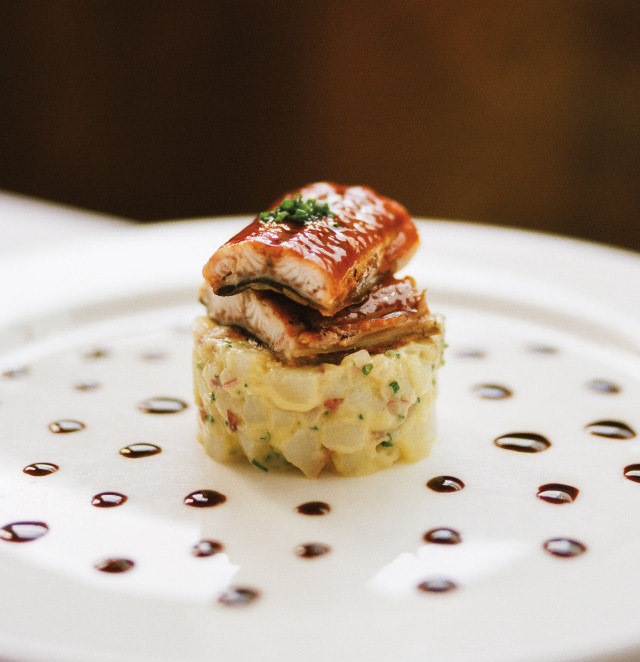
Image: Kyle Johnson
We live in the land of seafood aplenty (oysters! salmon!). Yet, when we want to go to a seafood restaurant, few choices come to mind. What are Seattle’s versions of the great fish houses of Boston or San Francisco?
More to the point—what can we eat in them? Increasingly informed diners want to know the sources of our food but find ourselves adrift on a troubling sea of reports about overfished waters, mislabeled seafood, and environmental threats. It’s enough to make a hungry seafoodie throw up her hands and order a grass-fed burger.
Read on. Seattle is a working port, encircled by water and loaded with fishermen—but it isn’t a fish-house town. Our best seafood dishes live in our high-end destinations, our ethnic joints, our holes-in-the-wall. Thanks to careful sourcing, well-managed stock, and conscientious chefs, there’s plenty of guilt-free seafood that tastes terrific. How to find it? We’ve found it for you.
Mashiko
Hajime Sato is steaming. “You can’t believe how many chefs I talk to who don’t know anything about the fish they’re serving!” he roars. “They order from the distributor and believe whatever the distributor tells them!” So distributors…lie? Sato laughs wildly. “Just last week I asked a distributor where his sea bass came from—actually first I asked him what’s sea bass anyway, there’s so much that gets sold under that name—and he just said, ‘South.’ I said, ‘South of where? Florida? Chile?’ And he said, ‘South means south, okay?’ and hung up.”
Before Sato turned his cozy and well-regarded West Seattle sushi bar into a 100 percent sustainable sushi bar, he didn’t know much more than anyone else about fish sourcing or endangered stocks. The more he learned, the more inspired he became to make a change. So four years ago he ditched the hamachi, the bluefin, the farm-raised salmon, the shrimp; he even began to serve a pretty decent freshwater eel substitute, namagi, made of catfish—beautifully cut and quite tasty, like all of his sushi. “Some people tell me I’m destroying sushi culture by saying you shouldn’t eat certain things,” he says. “I say if there are no fish left, we’ll have no sushi culture at all.”
So what rules does the sushi chef who calls himself “too hardcore for the Monterey Bay Aquarium Seafood Watch” propose for conscientious seafoodies? In general, he declares, local fish are best. Smaller, faster-growing fish (sardines, anchovies, mackerel) are better than big fish. Shellfish is generally great, assuming Dungeness crab over imported varieties. Seasonal fish is usually one’s best bet.

Image: Kyle Johnson
Etta’s
Somewhere along the way “Etta’s Seafood” became simply “Etta’s,” a decision Tom Douglas made to broaden the appeal of his most touristy property at the periphery of Pike Place Market. Still, that’s a whole lot of fish you’re seeing on Etta’s menus—making the festive cafe a particularly good find for lunch, when fewer fish houses are open—and Douglas’s Dungeness crab cakes are worthy of their hype, crisply fried with a high crab-to-fixings ratio. No breading, no heavy sauce. “What I preach to my chefs is that we have the most beautiful fish there is,” Douglas declares. “And somehow me or some other chef is gonna make that fish better? Our job is to get the fuck out of the way and let that thing shine.”
These days Douglas has a more pressing priority: keeping the fish around to begin with. He’s joined the crusade against the Pebble Mine in Alaska, the enormous proposed open-pit copper and gold mine at the watershed of Bristol Bay, where many of Seattle’s salmon fishermen earn a living and most of the salmon we eat originates. “It’ll poison the headwaters of the largest sustainable salmon run in the world,” Douglas warns. “It’s a travesty.
Lark
John Sundstrom offers a whole page of seafood choices at his elegant small-plate dinner house near Seattle U and has become known for his expert hand in cooking it. His baked eel, for instance—one of the few non-Japanese versions of the fish in Seattle—is sumptuous, glazed sweetly with saba, and perched atop a mound of aioli potato salad.
Like most Seattle chefs, Sundstrom keeps an eye on the shifting tides of eco-consciousness, and like many chefs he tries to find responsible sources, including one mom-and-pop operation on Lopez Island for oysters, another in Alaska for spot prawns. Still the eel issue remains tricky for him, since it is also on the Monterey Bay Aquarium Seafood Watch “avoid” list. Some customers chide him for carrying it; others beg him to never take it off his menu. “Eel doesn’t feel open and shut to me,” Sundstrom says. “If there were a coalition here that could make a dent in slowing the bigger tide of demand, most of which comes from Japan, yeah, I’d be a part of that.”

Image: Kyle Johnson
Tanglewood Supreme
Before Kent Chappelle was a restaurateur, when he was simply a Seattle native who relished a good plate of seafood, visiting friends would ask him to recommend a solid neighborhood fish house. He couldn’t. It perplexed him; this was Seattle for goodness’ sake. So he opened one.
Off an alley in Magnolia, Tanglewood Supreme is tiny and tasked with the impossible: feeding the demographic cioppino of old-timers and young families and professional sophisticates who live side by side in this peninsula neighborhood. He secured a liquor license. He installed an open kitchen. And he hired chef Jeffrey Kessenich, once Tamara Murphy’s top man at Brasa, who wrote a rotating menu of Northwest seafood—a recent one included several fresh oysters, Alaskan weathervane scallops, and three salmon dishes—in inventive New American platings.
A hunk of wild Alaskan king salmon—rod-and-reel caught in Alaska by Rick Oltman of Port Townsend’s Cape Cleare Fishery, then delivered locally—was lacquered delectably in a light glaze of tamarind and soy and served with a chunk of pork belly over carrot salad. A clutch of Hawaiian blue prawns arrived bright with cumin and citrus over turnip greens and grilled polenta. This Kessenich can cook—realizing Chappelle’s dream of great fish in the neighborhood, and all within a lively atmosphere that bubbles like a tide pool, lunch and dinner.
Tilth
Ten years ago when chef Maria Hines got wind that Alaska fishermen were selling fish right off their boats, she ran down to Fishermen’s Terminal. There she met Pete Knutson, the Seattle anthropology professor–slash–Alaska gillnet fisherman who had commissioned nets sized to the heads of sufficiently mature sockeye, thus reducing the yields of immature fish and unwanted species, called bycatch. Knutson’s fish blew her away. “It wasn’t battered up,” she marveled. “When you use one of those god-awful gigantic nets, crammed full of bycatch, you bruise the fish. You stress them. You can taste stress in an animal: It’s always tougher.”
Thus began a partnership that helped establish Hines’s first restaurant, Tilth, and continues to this day. (She laments that Fishermen’s Terminal regulations prohibit such sales from the docks—allowing sales only from boats tied up to the West Wall.) Many of Seattle’s most rarefied chefs bring the same finesse to seafood that they bring to everything they touch; especially good at fish are Jason Franey (Canlis), Jason Wilson (Crush), and Holly Smith (Cafe Juanita). But Hines, about a quarter of whose menu on a given night is seafood, was one of the first to credit fishermen on her menu.
She’ll take a piece of Knutson’s wild-caught sockeye that’s been flash frozen—the f-word chefs are no longer ashamed of, if frozen carefully in protective saline solution—then slow-cook it to retain moisture. Seafood plays to her strengths as a chef: a penchant for clean and delicate flavors and vegetal accompaniments. In August she might serve sockeye with corn and peppers and corn veloute; in spring with asparagus and morels. It makes for some beautiful dinner; a credit Hines throws back to Knutson. “It’s not from one of those giant fish companies that buy fish by the ton to have it sit at an airport or a holding tank,” she says. “I mean, Pete is family! He comes to our Christmas parties!”
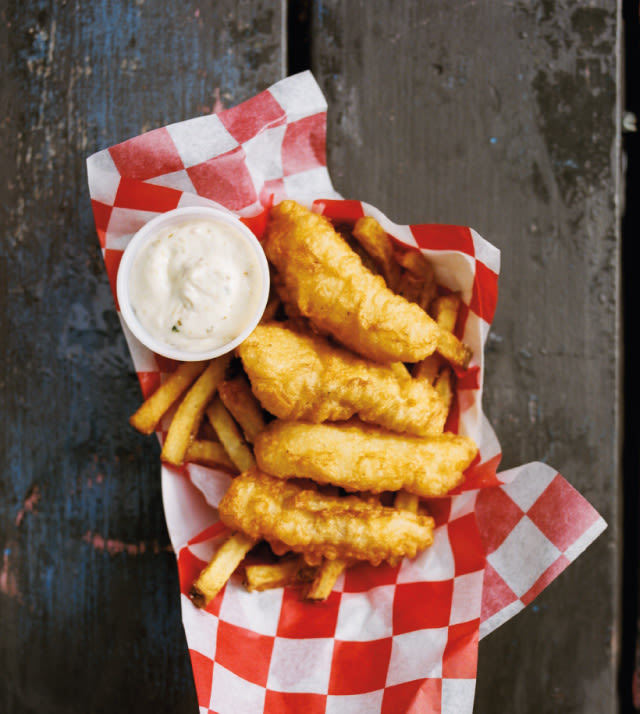
Image: Kyle Johnson
Pike Street Fish Fry closed
You might see a chef boning a halibut or a salmon at this hipster hole on Capitol Hill—something you don’t see every day at a fish-and-chips dive. It was opened by a team that included Mike McConnell (Caffe Vita, Via Tribunali) and Michael Hebb (the Ripe empire in Portland), so quality fish is prized—local cod, oysters, and calamari; Southern catfish; smelt and salmon in summer. Order cod and chips and the fish will be cloaked in golden batter, then beautifully fried in clean oil—oil you can hear bubbling over the ironic ’70s music—and served with not-entirely-greaseless (read: beloved) fries. Some five dipping sauces complete the experience lusciously.
Shiro’s Sushi
Four decades ago he was the first sushi chef in Seattle and he remains, by nearly every appraisal, the best. And though he’s down to working three days a week behind the bar at the minimalist little Belltown restaurant that bears his name (that’s Tuesdays, Thursdays, and Fridays), Shiro Kashiba still does every bit of the fish shopping those days. Delivery? Please. This is Shiro, and Shiro needs to look every geoduck in the, er…eye.
Indeed, pristine product is the better part of why he’s considered the best. Kashiba trolls the wholesalers—Ocean Beauty for Alaskan and local fish, True World for Japanese fish like yellowtail and sea bream—where he’s given appropriate leeway. “I’m kind of like an employee,” he shrugs impishly. He pops by Wong Tung, a mom-and-pop at the edge of the International District, for Manila clams and, in summer, what he considers the best spot prawns in Seattle. He visits Uwajimaya every day. And though he still holds Mutual Fish in the highest regard as one of the first suppliers to bring the freshest fish to the people, it’s just not the same for him anymore since the death of the founder at age 98 in the summer of 2012. “After Dick Yoshimura passed away…I don’t know…” he says, trailing off.
Kashiba spent his apprenticeship shopping the biggest fish market in the world, the teeming Tsukiji in Tokyo, where he learned the critical importance of eyes that are bright and gills that are red and watery. Issues like sustainability and overfishing are newfangled distractions for this old-school maestro; he just wants you to settle in at the bar and let him set you up with simple and beautifully cut omakase—chef’s choice—of whatever’s freshest that day. (Watch him cut—not for nothing does this old pro still win medals for speed.)
Restaurant Marché
One of Seattle’s venerable culinary leaders, Greg Atkinson, presents a mussels and fries for the ages at his Bainbridge Island Restaurant Marché. He starts with faultless sourcing—mussels from the folks at Taylor Shellfish Farms—then gives them a classic French treatment: a little Pernod, some heavy cream, a reduction with fresh fennel and plenty of mussel brine. The mussels arrive steaming in their shells, half submerged in their licoricey cream, and accompanied by a cone of crunchy twice-fried Kennebec frites sprinkled over with sea salt and fines herbes. Best mussels in the region.
Catfish Corner
They do one thing at this Central District (now Rainier Beach) takeout institution, and they do it consistently well. If it weren’t for Catfish Corner’s near-three-decade record in Seattle, the fish would be a lot rarer around here; some 26 other restaurants piggyback on its standing order to get delivery at all. Here is why they want it: catfish is flaky and sweet and weirdly nonfishy tasting. Plus, it rates high on the sustainability index; these ones come from an aquaculture outfit that maintains ponds of the whiskered bottom-feeders across the Deep South. At Catfish Corner it’s cut into strips, tossed in cornmeal and Cajun seasonings, then fried lightly without a trace of grease. Skip the frozen fries; choose hushpuppies and the house signature spicy tartar sauce.
Anchovies and Olives
Four years ago prolific restaurateur Ethan Stowell opened his sleek seafood spot, Anchovies and Olives, to showcase exotics from faraway waters—but overfishing and quotas have diminished supply and jacked up prices, and some of his original menu offerings—East Coast skate wing, monkfish—had to go.
Today his menu still holds rarely seen imports—John Dory, orata—along with unusual natives like geoduck crudo, and some half-dozen fish and shellfish pastas, uncommonly full-throated in flavor. The housemade bigoli pasta with anchovies, chili, and mint—Stowell’s very favorite dish in his empire—takes no prisoners. Indeed, Stowell’s impressive selection of seafood pastas offers the most affordable way to eat here.
But raising prices doesn’t have to be a restaurateur’s first response to the soaring cost of seafood, Stowell believes. In March he’ll open a charcuterie next door to Anchovies—a separate business with lower food costs, which will share enough efficiencies with its neighbor to function budgetwise as one. “Sharing efficiencies is the wave of the future in restaurants,” says the proprietor, who has done a version of this now with both Staple and Fancy (which he shares with Renee Erickson’s the Walrus and the Carpenter) and Rione XIII (which he shares with Heather Earnhardt’s the Wandering Goose). “It’s my way of making sure my seafood restaurant is sustainable.”
Seastar
When he opened the first Seastar restaurant in Bellevue in 2002, former Palisade chef John Howie’s goal was to build the best seafood destination in the region. At the very least, the creamy sprawler at the foot of a Bellevue high-rise may be the biggest. Business diners crowd the huge Bellevue branch, tourists the Seattle one—many of them clamoring for the two house signatures: the cedar-plank-roasted salmon, and the sesame-peppercorn-crusted ahi. The cooked and, effectively, the raw.
In general at Seastar, we favor the raw: overcooking and big sauces mask flavor on some of the cooked items, whereas Seastar’s crudo bar offers an uncommonly thorough array of sushi, ceviche, oysters, and pokes. The other thing Seastar does well is influence sourcing. Consider the freshwater coho salmon Seastar just began offering from SweetSpring near Olympia, an eco-farming operation with such pristine ways of eliminating contaminants and disease it’s earned the Monterey Bay Aquarium Seafood Watch “Super Green” seal of approval. Operations like Seastar are big enough to meaningfully support operations like SweetSpring (see box below)—and thus the promising new quest to recast fish farming from the bogeyman of sustainability to its biggest potential boon.
Sushi Kappo Tamura
Sushi chef Taichi Kitamura gets most of his fish from daily pilgrimages to Wong Tung Seafood and Uwajimaya, whose fishmongers save him San Juan sea urchin and an ugly little red fish from Alaska, longspine thornyhead, or idiot fish. Idiot fish is currently on watch lists, but Uwajimaya’s seafood manager, Ken Hewitt, insists that every product in his fish market is monitored for sustainability.
What does Kitamura do with the little idiots? He serves them whole (their boniness makes them more popular for home than restaurant cooks), then braises them with soy and ginger and burdock root. Kitamura is revered as a sushi chef, but the buttery white flesh of this fella is one reason so many regulars prize the quietly elegant Sushi Kappo Tamura for its cooked fish.
Branzino
This sexy, amber-drenched beauty in Belltown has achieved a quiet record of consistency with Italian seafood preparations—notably the eponymous branzino (Mediterranean sea bass), and perhaps the city’s best grilled octopus. Co-owner and veteran Seattle restaurateur Peter Lamb (Il Bistro, Queen City Grill) admits that he’s always wanted to open a simple, “butcher-paper” fish house—would it help if we beg?—but Branzino’s more intricate compositions are no booby prize. Tender octopus tentacles thick with char curl across a chunky, sure-handed puttanesca, bright with olives—a fine “starter octopus” for the squeamish. The branzino, presented as a whole fish then definned and filleted tableside, is all fluffy whitefish within a seasoned skin crackling from the Wood Stone oven, served on salsa verde, then topped with arugula and ribbons of fennel freshened with a light vinaigrette.
Ray’s Boathouse
It’s Seattle’s essential fish house—our vote for the best in town to bring a visitor—and not just for that astonishing wide-angle view over Shilshole Bay. In the ’80s, chef Wayne Ludvigsen launched a legacy of pristine sourcing that opened our eyes and wowed elites, including New York Times restaurant critic Ruth Reichl, who confessed to local seafood aficionado Jon Rowley that New York didn’t have anything approaching it.
Now about to reopen after a thorough remodel and menu revamp—we can’t say for sure how the new, more globally influenced seafood list from Mediterranean-loving chef Wayne Johnson will eat. (He does promise a version of the lobster paella he made famous at Andaluca.) There is one fish preparation Johnson knows he’d be nuts to remove, however: Chatham Strait sablefish in sake kasu. It’s been on Ray’s menu since Ludvigsen cheerfully stole the preparation from sushi master Shiro Kashiba (now of Shiro’s Sushi). Johnson has played with the plating, but the dish still bears its original hallmarks: the jasmine rice, the choy sum, and the marinated and broiled black cod, oozing its buttery oils.
Toulouse Petit
Eric Donnelly loves to catch fish, and he loves to cook fish—so much that he recently left his post as head chef of the pulsing New Orleans bar and restaurant Toulouse Petit to open a sustainable fish house of his own in Fremont, to be called RockCreek. (It’s expected later this spring; aka not soon enough.) As for the joint he’s leaving—that perpetually slammed, breakfast-to-wee-hours bar scene continues to dazzle us with its encyclopedic selection of seafood—the surprise being that it’s consistently carefully cooked. The huge menu still holds the same crudo and oysters, salmon and scallops, gumbos and jambalayas as ever. And if the owners continue to get the big things right as they improbably have till now—they especially won’t mess with the shrimp, cooked succulently every time, bursting with juice, and complemented with the fiery Creole sauces and cheesy grits
of the South.
Flying Fish
The busy Belltown fish joint that deserved its fame in the ’90s for admirable preparations of unusual seafood has drifted downstream since moving to a lively corner of South Lake Union. There, owner and chef Christine Keff hews to a familiar menu of old reliables, offering some 15-plus preparations of fish nightly—grilled swordfish in an olive tomato sauce, sharable platters of salt-and-pepper Dungeness crab with sesame noodles—making the F’ing Fish an obvious choice for groups with disparate cravings.
And an obvious choice for those who prize sustainability, a priority Keff pioneered around here. To wit: Much of the tuna (the current menu has three preparations) comes from a Hawaiian supplier who works with a fleet using deep-water nets, which target the deep-swimming adult tuna better than the long lines, which catch shallower-swimming younger fish. Once caught, the adult tuna are tagged so they can be followed all the way to market. It’s the only way to combat the rising problem of seafood fraud—the sort of fraud that sold 40,000 fish as “Copper River Salmon” last year, when only 12,000 had been caught.
Wild Ginger
Rick Yoder’s first restaurant job was shucking oysters at the pioneering seafood chain McCormick and Schmick’s, where he was trained by Mr. Oyster himself, seafood consultant Jon Rowley. From there he went on to launch the sprawling pan-Asian restaurants that would become tourist crowd-pleasers—the Seattle and Bellevue Wild Gingers—but he wouldn’t forget his original seaward leanings nor the essential role seafood plays across the cuisines of Southeast Asia.
As Asian restaurants go, Wild Ginger has typically appealed to conservative palates. But regard it as an Asian fish house, and suddenly it’s terrific. Suddenly it’s a restaurant, uncommonly swanky compared with the fish house dives of the International District, with one of the widest selections of carefully sourced fin- and shellfish in town—including crab and lobster in live tanks—prepared with fish-based components (fish sauce, shrimp paste—some of it housemade) that give Asian food its distinctive complexity.
Take the panfried sea bass, a dish Yoder abandoned for years when Chilean sea bass became the poster fish for unregulated harvesting. That fish has been a success story, now safely available from boats guaranteed by the Chilean and Argentine governments. His kitchen panfries the lush white fish with restraint, then lavishes it with fistfuls of fragrant Thai basil, dill, ngo gai, ngo om, and crushed peanuts. The result is one of the cleanest, most simply exotic fish plates in town.
The Walrus and the Carpenter
The outsize, New York Times–blessed popularity of the wee, whitewashed oyster bar in Ballard shocked no one more than its owner, chef Renee Erickson. “We get 200 people a night through 700 square feet,” she marvels. “I would’ve made it bigger if I’d have predicted it!”
We could’ve told you, Renee. For inside the elegantly quirky spot with the throbbing music and the hipster vibe, she forefronts some six to 12 oyster varieties a night—teensy Olympias; beloved Totten Virginicas; the latest find, Treasure Coves, with their wild texture and heavy liquor—alongside bare accompaniments and crisp libations. Chef Eli Dahlin crafts rarities like butter clam tartare with olive oil and lemon peel, or grilled sardines with walnut oil and shallots, or octopus with paprika and potato; that octopus might’ve arrived as the 40-pound bycatch from an order of halibut or spot prawns.
Erickson buys fish from all sorts of sources, including fishermen who roll up to her door from Salmon Bay across the street, but most distinguishing are the items she can score thanks to Walrus’s prodigious appetite. Herring typically gets sold almost immediately to Asia, but because of her relationships with suppliers she can take advantage of herring’s short season and snap up 1,000 pounds of the stuff. She’ll take it out of the commercial freezer in 50-pound lumps for Dahlin to make into herring rillettes or smoked herring tarts or herring grilled with potatoes and salsa verde—a blessed novelty in a neighborhood where most of the herring comes pickled.

